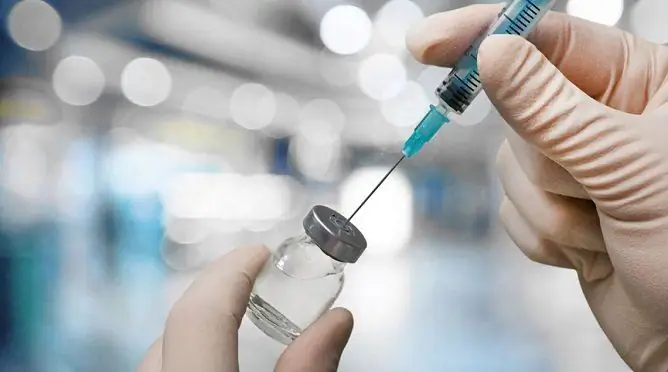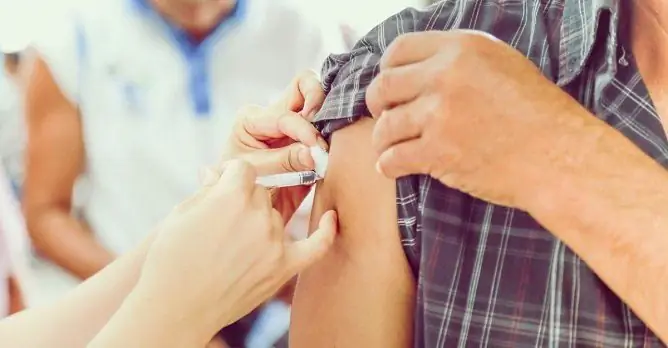- Author Rachel Wainwright [email protected].
- Public 2023-12-15 07:39.
- Last modified 2025-11-02 20:14.
Tetraxim
Tetraxim: instructions for use and reviews
- 1. Release form and composition
- 2. Pharmacological properties
- 3. Indications for use
- 4. Contraindications
- 5. Method of application and dosage
- 6. Side effects
- 7. Overdose
- 8. Special instructions
- 9. Use in childhood
- 10. Drug interactions
- 11. Analogs
- 12. Terms and conditions of storage
- 13. Terms of dispensing from pharmacies
- 14. Reviews
- 15. Price in pharmacies
Latin name: Tetraxym
ATX code: J07CA02
Active ingredient: vaccine against diphtheria, tetanus, whooping cough and poliomyelitis (Diphtheria, tetanus, pertussis, poliomyelitis vaccine)
Producer: SANOFI PASTEUR, SA (France)
Description and photo updated: 2018-29-11

Tetraxim is a vaccine for the prevention of diphtheria, tetanus, pertussis and polio.
Release form and composition
Dosage form - suspension for intramuscular (i / m) administration: turbid consistency, whitish color [1 dose (0.5 ml) in glass syringes with a fixed needle, 1 syringe in a cell package, in a cardboard box 1 package and instructions for use Tetraxima].
Active ingredients in 1 dose of suspension:
- tetanus toxoid - ≥ 40 IU (International units);
- diphtheria toxoid - ≥ 30 IU;
- pertussis toxoid - 25 mcg;
- filamentous hemagglutinin - 25 mcg;
- poliomyelitis virus type 1 inactivated - 40 units of D antigen;
- poliomyelitis virus type 3 inactivated - 32 U of D antigen;
- inactivated poliomyelitis virus type 2 - 8 U of D antigen.
Excipients: 2-phenoxyethanol, aluminum hydroxide, formaldehyde, Hanks medium 199 (without phenol red), water for injection, sodium hydroxide or acetic acid (to adjust to pH 6.8-7.3).
Antibiotics (neomycin, streptomycin and polymyxin B) are used in the production of the vaccine, but they are not present in detectable quantities in the final product.
Pharmacological properties
Pharmacodynamics
Tetraxim, administered according to the approved scheme, forms specific immunity against infectious diseases such as whooping cough, tetanus, polio and diphtheria.
In studies of immunogenicity conducted in children of the first year of life after the primary course of vaccination (administration of 3 doses of Tetraxim vaccine, starting from the 2nd month of life), it was found that 100% of the vaccinated had a protective antibody titer (> 0.01 IU / ml) to tetanus and diphtheria antigens.
With regard to pertussis antigens, after the initial course of vaccination, approximately 90% of children showed a 4-fold increase in antibodies to pertussis toxoid and filamentous hemagglutinin 1-2 months after the third dose of the vaccine. There is no empirically established serological criterion for protection, so a 4-fold increase in antibody titers is considered a sign of seroconversion.
After a course of immunization in at least 99.5% of children, antibody titers to poliovirus types 1, 2 and 3 exceeded level 5 (the reciprocal of the dilution in the serum neutralization reaction), which is considered sufficient to protect against poliomyelitis.
In studies of immunogenicity, conducted in children of the second year of life who underwent the primary course of vaccination (administration of 3 doses of Tetraxim), after the introduction of the 4th dose (revaccination), a high level of immune response to all components of the vaccine was established.
The results of studies in children 12-24 months who received the primary course of vaccination with three doses of vaccines with whole-cell pertussis component demonstrate that revaccination with Tetraxim is safe and immunogen for all its components.
Pharmacokinetics
The pharmacokinetic parameters of the vaccine have not been studied.
Indications for use
The Tetraxim vaccine is used to prevent pertussis, tetanus, poliomyelitis and diphtheria in children from 3 months of age.
Contraindications
Absolute:
- encephalopathy that developed within 7 days after the previous administration of any vaccine that contains Bordetella pertussis antigens;
- progressive encephalopathy (including those accompanied by seizures);
- allergic reactions to the previous administration of any vaccine for the prevention of diphtheria, pertussis, tetanus, poliomyelitis;
- a strong reaction that developed within 48 hours after the previous administration of a vaccine containing a pertussis component: a significant increase in body temperature (up to 40 ° C and above), prolonged unusual crying syndrome for 3 or more hours, hypotonic-hyporeactive syndrome, afebrile or febrile seizures;
- confirmed hypersensitivity to any vaccine component, glutaraldehyde, neomycin, streptomycin, or polymyxin B.
Time restrictions for the administration of Tetraxim are diseases accompanied by an increase in body temperature, infectious diseases in the acute period, exacerbation of chronic diseases. In all these cases, vaccination can be carried out after recovery / remission.
Tetraxim should be administered with caution to children who have a history of febrile seizures unrelated to previous immunization. In this case, within 48 hours after vaccination, you should carefully monitor the body temperature, and if it rises, use antipyretic drugs.
Due to the risk of bleeding, Tetraxim should be administered with caution in the presence of thrombocytopenia or other blood clotting disorders.
Tetraxim, instructions for use: method and dosage
The Tetraxim vaccine is administered intramuscularly at a dose of 0.5 ml. Recommended injection sites: for children under 2 years old - the middle third of the anterolateral surface of the thigh, for children over 2 years old - the deltoid muscle of the shoulder. It is forbidden to administer the vaccine intradermally or intravenously.
Immediately before injection, shake the suspension so that it acquires a homogeneous, turbid, whitish structure, and also make sure that the needle has not penetrated the blood vessel.
According to the National Calendar of Preventive Vaccinations, the course of immunization includes 3 vaccinations of Tetraxim at intervals of 1.5 months: at 3 months, at 4.5 months and at 6 months.
After 12 months (i.e., at the age of 18 months), revaccination is performed: one dose of the vaccine is administered intramuscularly.
If, for some reason, the immunization schedule is violated, the intervals between injections do not change, that is, they are 1.5 months between the doses of the primary vaccination and 12 months before the administration of the booster dose. Further revaccination is carried out within the time frame provided for by the National Calendar of Preventive Vaccinations. The doctor should be guided by the same calendar in all cases of violation of the recommended schedule.
Side effects
- reactions at the injection site: soreness, redness and induration of 2-5 cm in diameter - these reactions usually develop in the first 48 hours after vaccination, persist for 48-72 hours, pass on their own (without special treatment); less often - a seal more than 5 cm in diameter and edema spreading to one or both joints - these reactions usually appear 24-72 hours after Tetraxim vaccination, pass on their own (without special treatment) within 3-5 days. The risk of developing these side effects, presumably, increases with the number of injections of the acellular pertussis component (i.e., the probability is highest after the introduction of the 4th and 5th doses of the vaccine);
- general reactions from the body: increased body temperature [often (1-10%) -> 38 ° C, infrequently (0.1-1%) -> 39 ° C, rarely (0.01-0.1%) - > 40 ° C; the rectal temperature was assessed, and it is usually 0.6-1.1 ° C higher than the axillary temperature];
- others: decreased appetite, vomiting, diarrhea, drowsiness, sleep disturbances, irritability; rarely - atypical or prolonged crying; very rarely (<0.01%) - skin rashes, urticaria, hypotension, hypotonic-hyporeactive syndrome, febrile and afebrile convulsions, anaphylactic reactions (facial edema, angioedema, shock).
In deeply premature babies (born at 28 weeks of age and earlier), the time interval between breaths may be lengthened for 2-3 days after the vaccine is administered.
There is evidence that after the administration of vaccines with a tetanus toxoid component, some children developed neuritis of the brachial nerve and Guillain-Barré syndrome. This information should be taken into account when using Tetraksim.
Overdose
Overdose cases have not been reported to date.
special instructions
Parents of children who have been injected with Tetraxim should inform the doctor about any adverse reactions, including those not described in the instructions for use.
In order to avoid the development of allergic reactions, before each vaccination, the doctor must clarify the child's state of health, the history of his immunization and diseases (including allergic history), and also find out if there have been any side effects with previous injections of any vaccines. The vaccination room must provide medicines and tools necessary to eliminate hypersensitivity reactions.
In conditions of immunodeficiency and immunosuppressive therapy, a decrease in the immune response to the administration of Tetraxim is possible. Vaccination of such children is recommended to be postponed until remission of the disease or the end of therapy. However, for patients with chronic immunodeficiency (eg, HIV-infected) vaccination is recommended even if the immune response is likely to weaken.
The suspension should be administered with caution in patients with thrombocytopenia and other blood clotting disorders, since there is a risk of bleeding during injection.
Very premature babies (born at 28 weeks of gestation and earlier) are at potential risk of developing apnea, especially if there is a history of signs of respiratory immaturity. Such children should have respiratory control within 48-72 hours after the vaccine administration. The benefits of immunization are higher than the potential risks, so vaccination should not be delayed or discarded.
The decision to prescribe Tetraxim to children in whom the administration of any vaccine containing tetanus toxoid has caused the development of brachial nerve neuritis or Guillain-Barré syndrome should be made by the attending physician, carefully assessing the balance of benefits and possible risks. In such cases, completion of the primary immunization is usually justified (if less than three doses have been administered).
Influence on the ability to drive vehicles and complex mechanisms
Tetraxim is used only in young children, therefore, no studies have been conducted on the effect of the vaccine on reaction rate and ability to concentrate.
Pediatric use
Tetraxim is used according to the National Vaccination Schedule, starting from 3 months of age.
Drug interactions
With the exception of immunosuppressive therapy, there is no reliable information on possible interactions with the simultaneous use of other drugs.
Tetraxim can be administered simultaneously, but in different parts of the body, with vaccines against chickenpox, measles-mumps-rubella, hepatitis B.
Tetraxim can be administered with the Act-HIB vaccine (against diseases caused by Haemophilus influenzae type b) in one syringe (in this case, the Act-HIB vaccine is diluted with the Tetraxim vaccine) or simultaneously with different syringes in different parts of the body.
In rare cases, with the simultaneous administration of vaccines containing the CIB component, edema of one or both lower extremities occurred (when the vaccine was administered in one syringe, edema prevailed in the leg into which the vaccine was given). Edema was noted mainly in the first few hours after the primary vaccination. Sometimes this reaction was accompanied by soreness, fever, discoloration of the skin or cyanosis (less often redness), rash, transient purpura, petechiae, and prolonged crying. These reactions self-passed within 24 hours without residual effects and did not cause any undesirable effects on the part of the respiratory and cardiac systems.
Before vaccination, parents should inform the doctor about all medicines that are used to treat the child at the time of vaccination or have been used in the recent past.
Analogs
Analogs of Tetraxim are: Tetrakok 05, Pertussis-diphtheria-tetanus adsorbed vaccine (DTP-vaccine), Infanrix [Vaccine for the prevention of diphtheria, tetanus, pertussis (acellular) three-component adsorbed liquid], Hepatic B vaccine, columnar, diphtheria Vaccine DTP-Hep B), Combined vaccine of hepatitis B and diphtheria-tetanus toxoid with a reduced content of antigens.
Terms and conditions of storage
Keep out of reach of children at 2-8 ° C (refrigerator). Do not freeze.
The shelf life is 3 years.
Terms of dispensing from pharmacies
Dispensed by prescription.
Reviews about Tetraxime
According to reviews, Tetraxim is a quality vaccine from a well-known French manufacturer, which provides protection against four infectious diseases at once, is well tolerated and does not cause side reactions.
There are reports of the development of adverse reactions after vaccination (mainly a slight increase in body temperature, soreness at the injection site, lethargy, drowsiness), but they were not very pronounced, so parents do not attribute them to serious shortcomings of the vaccine. The only drawback, according to the majority, is the problem with the acquisition of Tetraksim, since it is often not available in pharmacy chains.
The price of Tetraxim in pharmacies
The price of Tetraxim is unknown as the vaccine is currently not available commercially. It costs about 3,680 rubles to get vaccinated in a private clinic.

Maria Kulkes Medical journalist About the author
Education: First Moscow State Medical University named after I. M. Sechenov, specialty "General Medicine".
Information about the drug is generalized, provided for informational purposes only and does not replace the official instructions. Self-medication is hazardous to health!






